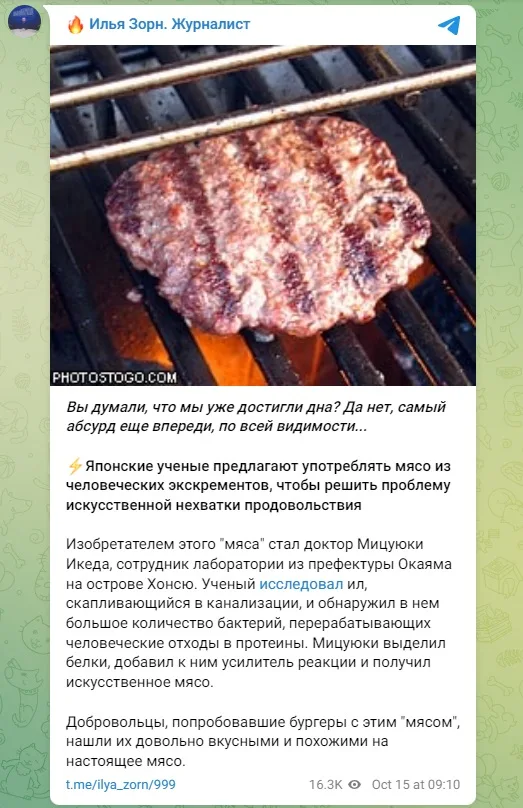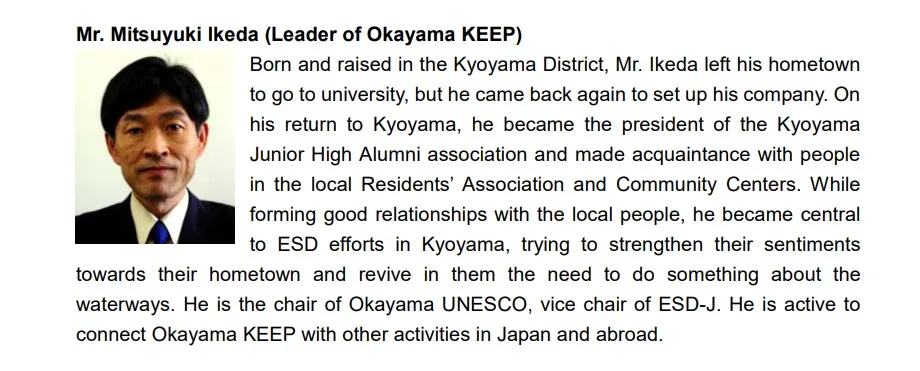In the fall of 2022, publications appeared on social networks about a development that could solve the problem of food shortages in the world. We have verified the accuracy of such messages.
According to Internet users, a laboratory worker from Okayama Prefecture on the island of Honshu named Mitsuyuki Ikeda discovered in the sludge that accumulates in the sewer a large number of bacteria that can process feces into proteins. Scientists were allegedly able to isolate proteins, obtain artificial meat from them, and even prepare burgers, which they gave to volunteers to try - they “found them quite tasty and similar to real meat.” In October 2022, Telegram channels talked about this (for example, “Coincidence" with 286,000 subscribers), users "VKontakte" And Facebook*. “You thought we had already reached rock bottom? No, the most absurdity is yet to come, apparently,” the authors of these posts commented on the message.

Let's start with the fact that this story is already more than ten years old - in June 2011, many major media outlets, such as Russian ones, told about it (RBC, "Komsomolskaya Pravda", "Express newspaper", News.ru, "Arguments and facts"), and foreign (Fox News, Daily Mail, Digital Trends). In 2015, Mitsuyuki Ikeda talked about the development of “Jellyfish»** and again Fox News, in 2016 - Life.ru.
Back in 2011, journalists wondered where major media outlets from different countries got information about Mitsuyuki Ikeda’s invention. What was especially suspicious was that none of the journalists who published the news attempted to interview the author of the idea, so suitable for a loud headline. At Okayama University indeed There is several scientific laboratories, also operating in the province Chemical laboratory for the study of biomass (she does cellulose research), but their websites make no mention of Ikeda and/or his acclaimed research.
That being said, a man named Mitsuyuki Ikeda does exist. For example, it is mentioned on the website of the Japanese Ministry of Environment - back in 1996 Ikeda received from the department the status of environmental advisor (annually for this public position are taken away from one and a half to three dozen people). The ministry’s website also states that the man specializes in problems of water quality and global warming, and his place of activity is Okayama Prefecture. Ikeda's profile also states that he was "involved in environmental NGOs as vice-chairman of the Okayama UNESCO Association," served as a member of the environmental subcommittee of the Okayama City Integrated Policy Council, and gave numerous lectures at schools and other institutions. Ikeda is a “professional engineer” by training, although the ministry does not specify where exactly he received his diploma.
Although Ikeda mentioned in several Internet publications in Japanese posted on the Internet before 2011, none of them included his proposed method of creating artificial meat. In turn, Japanese-language messages on this topic began to appear already after Western media reported on the invention in mid-June 2011. We were unable to find any relevant academic articles authored by Ikeda, press releases issued by the local university, or reports in local newspapers.
Our colleagues 11 years ago decided to find out where Fox News, Daily Mail and other major publications learned about the possibility of creating artificial meat based on human excrement. The process details and numerical values outlined in their publications coincide with video, which lasts about two and a half minutes and was published on April 11, 2011 on YouTube by ill318 (1,440 subscribers). As the source of the video, which has now been viewed 1.74 million times, the author of the channel indicates the LiveLeak website (now closed British competitor YouTube at the turn of the 2000s and 2010s) - the same video is there appeared the day before. At the same time, there are earlier copies of the video on YouTube - one of them was published blogger ahscotty (945 subscribers) in October 2010 and gained about 90,000 views over 12 years.
Journalists who studied this video noticed many oddities in it.
- In the description of the process of turning excrement into artificial meat, the purification of the “raw materials” from metals, toxins, chemicals and other dangerous and simply inedible elements entering wastewater is completely ignored - a scientist would probably talk about such important details.
- When showing photographs of “meat,” Ikeda uses a very strange pointer—its top depicts a woman’s hand with a protruding finger.
- On the refrigerator where the “meat” is supposedly stored, there is a sign with Japanese characters and the English phrase Shit Burger (“shit burger”) defiantly pasted on it—it is not entirely clear why the scientist would call the result of his research so vulgar (albeit intelligibly).
- In the video, the man shows printouts of media publications dedicated to his discovery and written in different languages. It was not possible to find these materials.
- For almost two and a half minutes of the video, the authors of the story did not show a single colleague who would work on the project with Ikeda.
- In the final part of the video, its main character for some reason imitates defecation (while being fully clothed), and then eats a burger with artificial meat allegedly developed by him.
- The final frames of the video show a banner with an inscription in Chinese (not Japanese).
At the same time, neither the video itself nor the accompanying materials on different platforms say where and when exactly it was filmed. In the lower right corner of the video there is a logo (probably for a TV channel) with the letters TWO, but we were unable to find out which organization or media company it belongs to.
Although there are many questions about the video, it does indeed depict Ikeda. But in the video that went viral in 2011, he looks noticeably younger than in the portrait from the document, compiled five years earlier. Considering that Ikeda was born in 1959, in the early 2010s he was slightly over 50, while in the video the Japanese man looks significantly younger.

This discrepancy can be explained by the fact that the video posted in 2010 and went viral in 2011 is not at all the primary source of the story about the processing of waste into artificial meat. How found out journalist Justin Elliott, a very similar story involving the same Mitsuyuki Ikeda appeared in English-language newspapers back in the mid-1990s, when he was about 35 years old. We were able to find similar publications, for example, in the British The Guardian and Australian Brisbane Courier Mail (both date from the first half of October 1993). There, in particular, it talks about the potential of using “meat” created according to Ikeda’s recipe for feeding livestock.
Both Elliot and his colleagues from others publications sent letters with their questions to Ikeda and the reporters who wrote about him in the mid-1990s. Judging by the fact that the authors of the analyzes directly promised to update the text if they received a response, but did not do so, Ikeda never commented on the situation for them.
Thus, publications in a number of media outlets that appeared en masse in the summer of 2011 were based solely on a YouTube video filmed in an unknown place and at an unknown time. The technology for processing feces into meat presented in the video and the facts related to this process are not reflected in scientific publications, and its creator Mitsuyuki Ikeda spoke about his invention only twice: in October 1993 to several Western media and on a viral video in the early 2010s (which, judging by the quality and appearance of the Japanese himself, could have been filmed then, in 1993). Subsequently, Ikeda did not give any comments on this matter, although he continues to be involved in environmental activism.
*Russian authorities think Meta Platforms Inc., which owns the social network Facebook, is an extremist organization; its activities in Russia are prohibited.
**Russian authorities consider Meduza to be a foreign agent.
Cover photo: Pixabay
Most likely not true
- J. Elliott. The mystery of the Japanese "poop burger" story
- N. Arumugam. Meat Made From Human Feces: Hoax or Japan's Best New Invention?
- Is it true that eating soy is harmful to health?
- Is it true that food additives are dangerous to health?
If you find a spelling or grammatical error, please let us know by highlighting the error text and clicking Ctrl+Enter.






